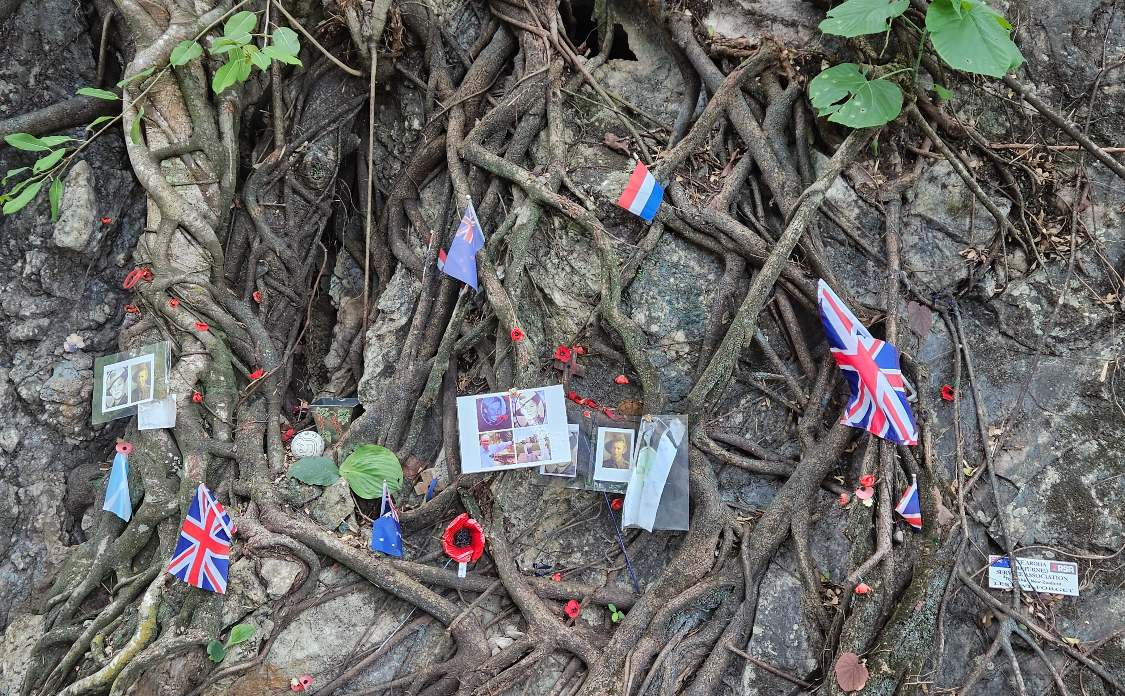Anzac Day in Kanchanaburi: Tracing the Footsteps of History’s Heroes
Are you planning to spend Anzac Day in Kanchanaburi or perhaps visiting Thailand in late April? Spending Anzac Day joining a dawn service or exploring Kanchanaburi’s War Memorials at any time of year is an excellent way to learn more about Thailand and the Allied Forces’ involvement in WWII. We have written this page to help you plan your itinerary; we hope it helps you have a memorable visit.
Kanchanaburi is a gorgeous part of Thailand known for its scenic waterfalls and beautiful landscape. Nestled on the River Kwai, tourists from around the world flock here in droves.
However, Kanchanaburi has a solemn history, one which is respectfully told in several war memorials, museums and cemeteries. These are the real reasons to visit Kanchanaburi; this is my guide to which one’s matter most.
I’ll start with the most well-known landmark in Kanchanaburi, the Bridge Over the River Kwai; while there, I’ll visit the Concentration Camp Market right at the bridge’s southern end. Afterwards, I’ll head to the Thai-Burma Railway Museum and the JEATH Museum.
I’ll visit two significant cemeteries to pay tribute to those who lost their lives during the war and finally stop at the Hellfire Pass museum to look at Australia’s connection.
- The Bridge over the River Kwai: A Symbol of Triumph & Tragedy
- The Thailand-Burma Railway Centre
- Concentration Camp Market: A Reflection on the Past
- The JEATH War Museum: An Insight into the POW Experience
- Remembering the Fallen: Exploring War Cemeteries in Kanchanaburi
- Hellfire Pass Museum: Australia’s Link to Thailand
- Anzac Day in Kanchanaburi: An Opportunity to Remember
- Resources on Kanchanaburi
- Kanchanaburi: A Gateway to the Past
The Bridge over the River Kwai: A Symbol of Triumph & Tragedy
The Bridge over the River Kwai is an iconic symbol of Kanchanaburi’s World War II history. Built by the forced labour of prisoners of war (POWs) under the harsh reign of the Japanese military, the bridge stands as a stark reminder of the cruelty of war, the indomitable human spirit, and the heavy price that was paid for it.
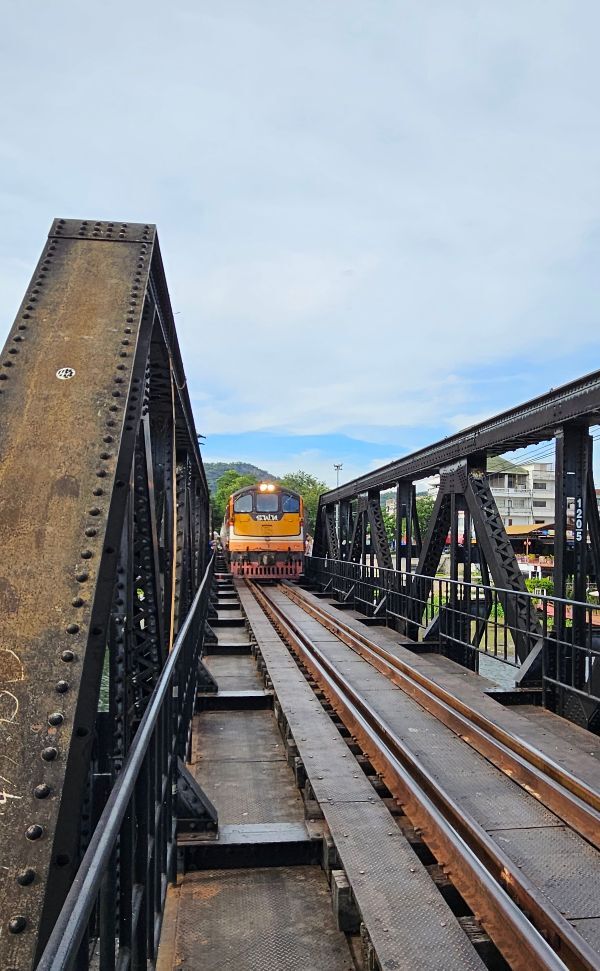
Visiting the bridge, you’ll notice plaques commemorating the casualties of all nationalities who gave their lives for its construction. Read more about our visit to the bridge.
Over 100,000 forced labourers were used in the construction of the Death Railway.
While it may now serve as a tourist landmark, the haunting echoes of its past seep through the camera clicks. Thousands of people come here yearly to pay their respects, making it an esteemed war memorial that forms a tangible link to the past.
The Thailand-Burma Railway Centre
Embarking on a tour of the Thailand-Burma Railway Centre, you’ll witness many significant exhibits. Upon your arrival, you’ll notice the life-sized figures depicting scenes from the railway’s construction — an eerie reminder of the gruelling conditions endured by the POWs. They’re so carefully crafted that they bring another era to life right before your eyes.

As you step into the heart of the museum, check out the comprehensive collection of wartime artefacts. From personal items of the labourers to tools used during construction, these artefacts provide a tangible connection to history.
Another feature of the museum is the relief maps. These are painstakingly rendered to show the route of the Death Railway, providing an engrossing bird-eye-view of this remarkable yet haunting feat of labour.
While wandering the halls, you’ll encounter a detailed and moving multimedia presentation. This emotionally charged account, filled with photographs and testimonials from survivors, gives you an immediate knowledge of their unimaginable experiences and sacrifices.
Concentration Camp Market: A Reflection on the Past
The Concentration Camp Market is on the riverbank next to the southern pylons of the River Kwai Bridge. What’s unique about this market is its location. It’s on what used to be the site of a World War II POW camp.
As you stroll along the bustling stalls, you’re literally walking on land that witnessed deeply profound chapters of human history. The market speaks of the resilient spirit of those who once suffered here while serving as a community hub for present-day locals.
The Concentration Camp Market is more than just a regular Thai market. It provides a raw, authentic avenue to connect with Kanchanaburi’s past in a more grounded, everyday context. Gazing at the locals going about their daily lives, you can’t help but reflect on the stark contrast between the past and present.
You can find fresh local produce and mouth-watering street food, clothing, souvenirs, and arts and crafts along the rows of stalls. Nothing there directly harks back to the war era, but I encourage you to take a moment as you shop. Just pause and recognise the living history beneath your feet.
The JEATH War Museum: An Insight into the POW Experience
If you visit the JEATH War Museum in Kanchanaburi, you’re in for a profoundly moving experience. This place is a frozen snapshot of the prisoner of war experience during WWII.
The exhibitions have been carefully curated to offer an insight into the harrowing conditions in which these prisoners lived and worked. Inside the museum, you’ll discover artefacts such as letters, paintings and photographs, mostly left behind by these prisoners.

There’s a bamboo hut replica that’s modelled after the original POW accommodation. Art made by the prisoners, historical accounts, stylised replicas of bomb fragments and artefacts of daily life further enriches the visitor’s understanding. While it’s a sobering glimpse into the harsh realities of war, it’s also a profound reminder of human resilience.
The museum’s collection of personal wartime stories, told through letters and illustrated with sketches, provides an emotional journey into the prisoners’ minds. These first-hand narratives bring a unique authenticity to the museum.
As you wander through the exhibits at the JEATH War Museum, remember that each artefact tells a story of ordinary people living through extraordinary times.
Remembering the Fallen: Exploring War Cemeteries in Kanchanaburi
The most significant tragedy of all was the sheer volume of prisoners who lost their lives during the building of the Death Railway. There are two cemeteries in Kanchanaburi, the final resting places of these souls, and I encourage everyone to visit both and pay your respects.
Don Rak War Cemetery
First on my list of war cemeteries in Kanchanaburi is the well-known Don Rak War Cemetery, also known as Kanchanaburi War Cemetery. With over 6,000 graves, it serves as the final resting place for primarily British, Dutch and Australian prisoners of war.
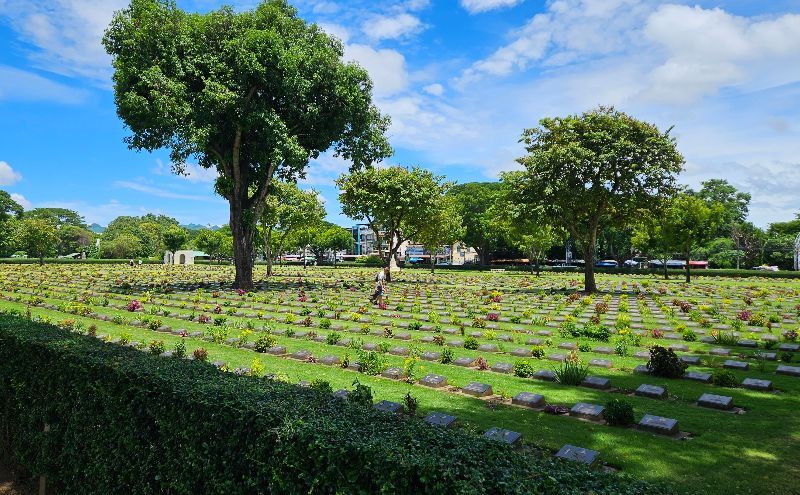
Chong Kai Allied War Cemetery
Next up, I recommend you visit the Chong Kai Allied War Cemetery. With just under 2,000 graves, it’s smaller than Don Rak. This cemetery holds the remains of POWs of various nationalities — including Australians, Dutch, Americans, and Britons — giving them a dignified farewell on the banks of the pristine Kwai River.
Hellfire Pass Museum: Australia’s Link to Thailand
Located in the secluded area of the Tenasserim Hills, the Hellfire Pass Museum is a place of discovery. Named ‘Hellfire Pass’ for the harsh, brutal conditions endured by labourers during its construction, the site is renowned for being the most challenging section of the Thailand-Burma Railway.
The comprehensive display includes an informative audio tour that will transport you back to those times in the 1940s when POWs and Asian labourers faced inhuman conditions to complete this railway.
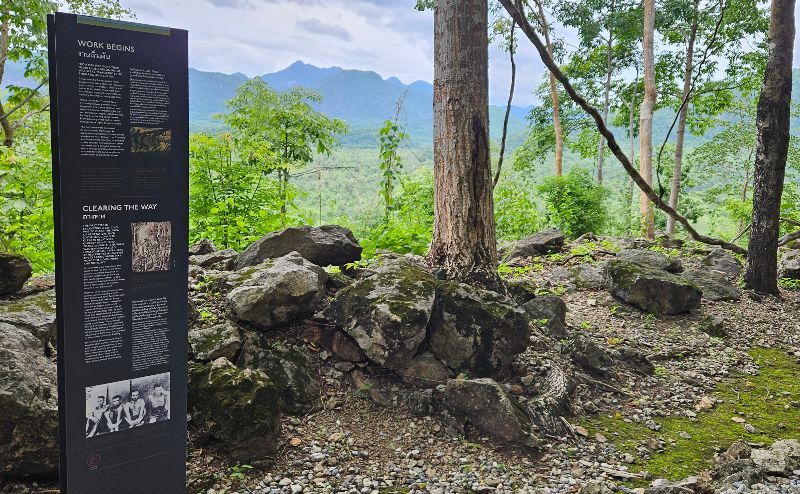
Walking along the museum’s interactive trails that peek into the dense jungle surrounding the area prompts a solemn exploration experience.
If you only have time to visit one War Memorial in Kanchanaburi, make it this one.
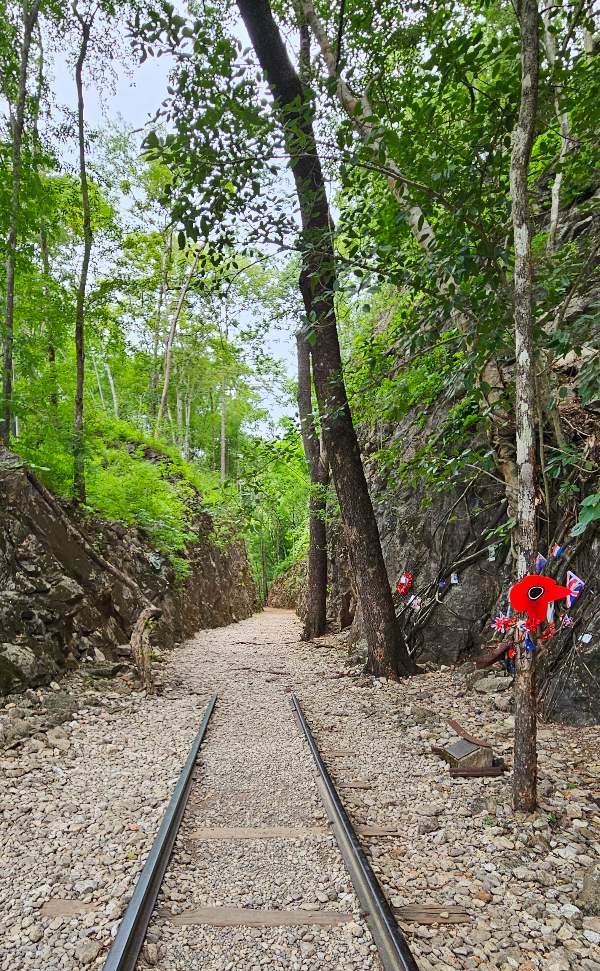
Many of the prisoners of war who laboured on the railway under such gruelling conditions were Australian soldiers. Hence, the museum, funded by The Australian Government and overseen by The Office of Australian War Graves, is a humbling tribute to the brave men who suffered and lost their lives.
Anzac Day in Kanchanaburi: An Opportunity to Remember
Each year, as dawn breaks on the 25th of April, hundreds gather in Kanchanaburi for Anzac Day at the Hellfire Pass Museum.
This early morning service, held by the light of flickering candles, is profoundly moving. It’s not uncommon to spot tears in the crowd as the strains of ‘The Last Post’ echo around the still-dark cemetery.
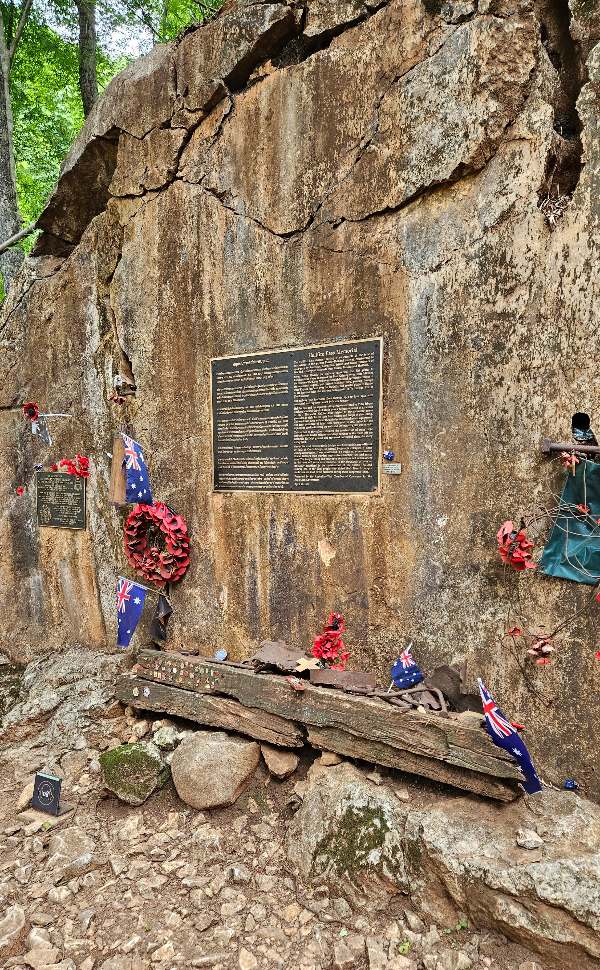
Personally, I cherish the opportunity it provides to reflect on the sacrifices made by these brave souls. It’s also a great chance to connect with the broader Australian and New Zealand communities, who turn out in large numbers for the service each year.
The tradition of Anzac Day in Kanchanaburi is more than just a ritual; it’s a vital chance to honour the past and to bear witness to the stories of those who suffered here. Whether you’re a history buff or simply a traveller keen to understand the depths of this region’s past, it’s an experience that will undoubtedly resonate with you deeply.
Check opening hours and closure dates before you plan your visit.
ANZAC Day: Dawn Service & Gunfire Breakfast
Continuing the tradition of honouring the sacrifices made by the Australian and New Zealand Army Corps (ANZAC) during World War I, Anzac Day is a significant day of remembrance in Australia and New Zealand. For travel enthusiasts and history buffs, attending the Dawn Service and Gunfire Breakfast is a unique opportunity to pay tribute to the ANZACs and engage in a meaningful commemoration.
The Dawn Service, held at 5:00 am, symbolises the time when the Anzac troops landed at Gallipoli in 1915. It is a solemn ceremony that brings together people from all walks of life to remember the bravery and service of the ANZACs.
Following the Dawn Service, the Gunfire Breakfast is a tradition that provides an opportunity for attendees to gather and share a meal. This gathering allows community members, veterans, and their families to come together and connect over shared experiences. It is a chance to not only honour the ANZACs but also to create new memories and strengthen the bond within the community.
Tips for attending Anzac Day Services in Kanchanaburi
Plan to arrive in at least one day before Anzac Day. The trip from Bangkok to Kanchanaburi is straightforward with train, bus and private transfers available.
- Dawn services are held at Hellfire Pass Interpretive Centre at Konya Cutting 80km from Kanchanaburi town centre. It’s vital you have your transport arranged in advance.
- Plan to arrive between 3-4am to allow you time to get into place for the memorial – the site opens at 3am
- Kanchanaburi typically experiences intense heat towards the end of April. Temperatures of 40 degrees are not uncommon. Dress in lightweight breathable fabrics that are respectful.
- It is challenging to reach the historic railway section at Hellfire Pass if you have any mobility issues however a live broadcast is display around the site.
- Bring some bug spray you will likely need it!
- Wear practical shoes, there are many steps and gravel paths at Hellfire Pass.
- Bring a small flashlight (or use your phone) for navigating the path Dawn Service location at Hellfire Pass.
The commemoration of Anzac Day in Kanchanaburi at Hellfire Pass Museum is an incredibly moving experience that serves to remember the fallen and the brave.
Resources on Kanchanaburi
These resources offer a more in-depth view of the region’s wartime history in both fact and fiction, allowing for a deeper understanding of the trials and triumphs of Kanchanaburi’s past.
Books About Kanchanaburi’s WWII History
Let’s start with a couple of interesting reads:
- The Bridge over the River Kwai by Pierre Boulle – Even though it’s a fictional tale, this book captures the essence of the prisoner of war experience and the construction of the infamous bridge.
- The Narrow Road to the Deep North by Richard Flanagan – Based on Flanagan’s own father’s experiences as a prisoner of war, this Man Booker Prize winner is a must-read for its portrayal of endurance and survival during the time.
Films Reflecting the Wartime Experiences
Moving on to the world of cinema:
- The Bridge on the River Kwai (1957) – This seven-time Academy Award winner is loosely based on Pierre Boulle’s novel and offers a dramatic depiction of the lives of the POWs.
- To End All Wars (2001) – A lesser-known film but equally as impactful, this movie showcases the hardships of the prisoners in the Thai jungles.
Kanchanaburi: A Gateway to the Past
Kanchanaburi’s rich WWII history is reflected through its war memorials and museums.
The Bridge over the River Kwai speaks volumes of both triumph and tragedy. It symbolises the duality of man’s capacity for outstanding achievement despite significant suffering.
The Thailand-Burma Railway Centre, a fascinating journey through time, provides an in-depth understanding of the region’s wartime affairs. Further, the JEATH War Museum offers a unique insight into what Prisoners of War endured. All of these places are testimonies of resilience and remembrance.
Equally significant are the war cemeteries, Don Rak and Chong Kai—a humbling homage to the souls who lost their lives during those tumultuous years.
And so, Kanchanaburi stands not only as a city but also as a gateway that guides us to a critical chapter of Thailand’s past, one marked by resilience, sacrifice, and a yearning for peace.
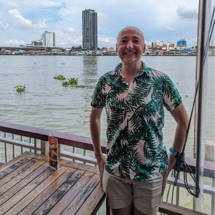
About the author: Stephen left Australia in 2016 with a one-way ticket to Thailand
and hasn’t been back since. Seven years later, he’s “living the ex-pat dream”, married and settled down; he and his partner travel across Thailand competing in half-marathon running events and sampling coffee at cafes.

